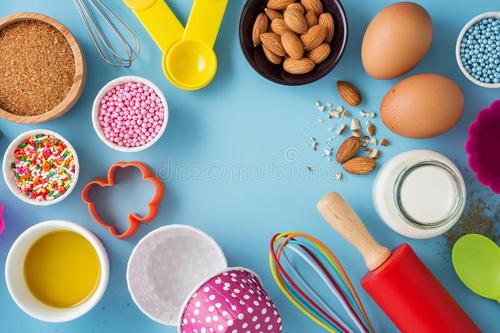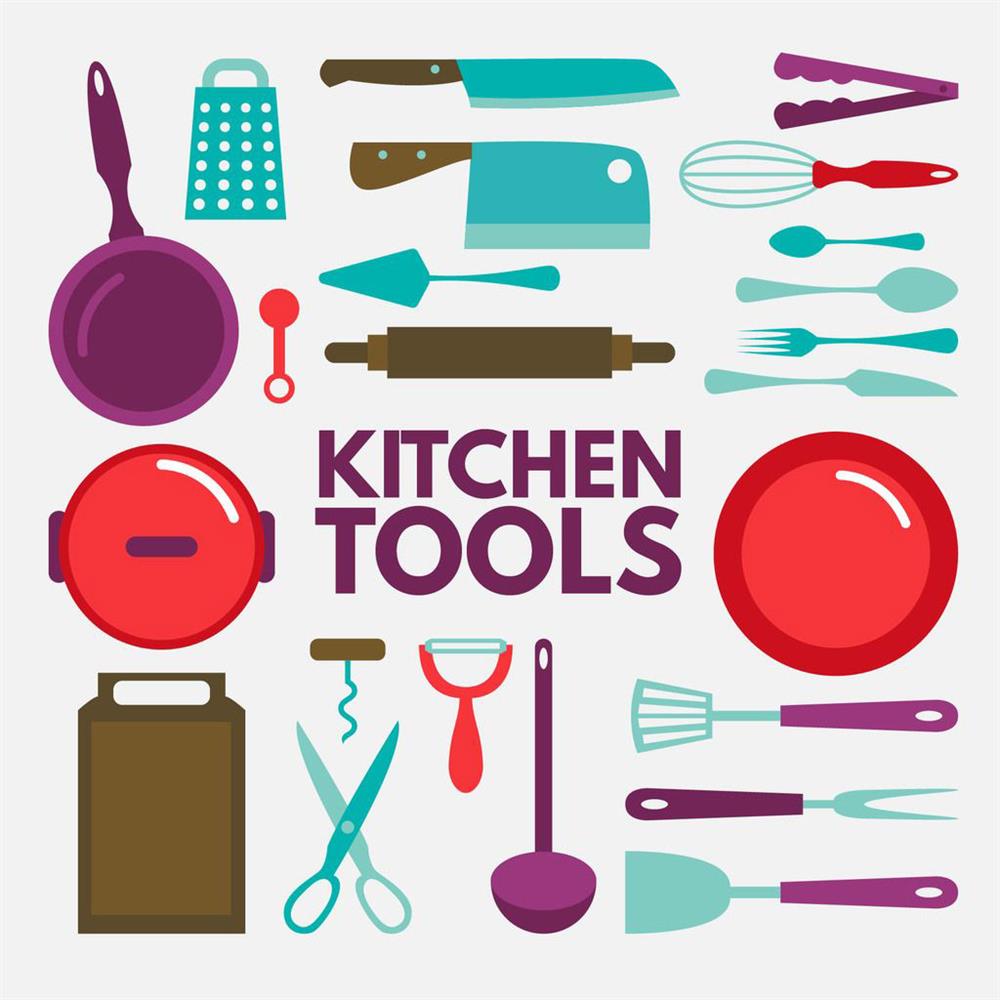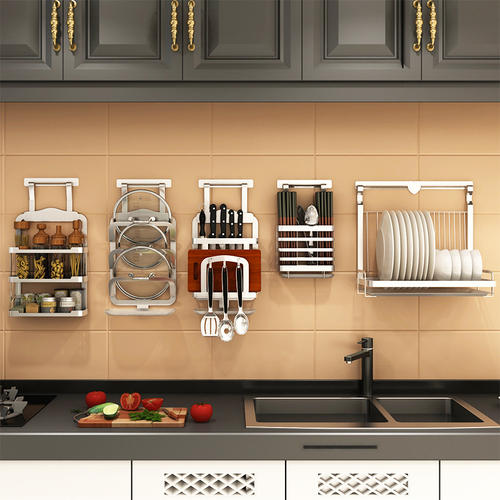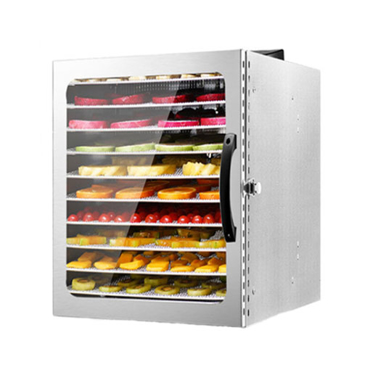Kitchen Tools
26 Piece Home Complete Deluxe Barbecue Tool Kit
Kitchen tools classification
There are two ways to classify:
1. According to the using occasion, kitchen tools can be divided into commercial kitchen tools and household kitchen tools.
Commercial kitchen tools are suitable for large-scale kitchen equipment such as hotels and restaurants, and household kitchen tools are generally used in families.
2. According to the purpose, it can be divided into five categories as follow:
- First one is storage utensils, which are divided into food storage and utensils storage. Food storage can be divided into refrigerated storage and frozen storage. Utensils storage is to provide storage space for tableware, cookware, utensils, etc. storage utensils are completed through various base cabinets, wall cabinets, corner cabinets, and multifunctional decorative cabinets.
- The second category is washing utensils, including hot and cold water supply systems, drainage equipment, wash basins, wash cabinets, etc. The garbage generated in the kitchen operation after washing should be equipped with trash bins or sanitary buckets. Modern family kitchens also Equipment such as disinfection cabinets and food waste shredders should be equipped.
- The third category is conditioning appliances, which mainly include conditioning countertops, sorting, cutting vegetables, ingredients, preparation tools and utensils. With the advancement of conversion technology, food cutting machines, juicers, grain mills, and brewing machines for home kitchens are also increasing.
- The fourth category is cooking utensils, mainly stoves and related tools and utensils for cooking. With the progress of the kitchen revolution, waffle maker, rice cookers, high-frequency induction cookers, microwave ovens, etc. have also begun to enter the home in large numbers.
- The fifth category is eating utensils, which mainly include furniture in restaurants and utensils for eating.

How to select the best kitchen tool for you?
- One of the general development trends of kitchen equipment is the increase in stainless steel products. Compared with traditional aluminium products, iron products, and enamel products, it has many advantages:
- Aluminium products are easily oxidized and corroded, iron is easy to rust, and enamel products are afraid of corrosion. The stainless steel products are not oxidized and corrosion resistant.
- Aluminium is low in strength, afraid of abrasion and collision, and easy to shape. Although ceramic products are hard but very brittle, they also are afraid of collision, while stainless steel products are not afraid of it.
- Aluminium products are easy to adsorb objects, causing bacteria to grow, and it will turn to be black after oxidation, which is not easy to clean up, then affects the appearance. Conversely, stainless steel has hard texture, good finish, few attachments, and is relatively hygienic.
- From the perspective of the impact on the human body, some people abroad call aluminium cookware “the thief who steals life”, and believe that if the aluminium content of human body exceeds 50-100 mg, it will cause premature aging.
It can be seen from the above four points that it is imperative for stainless steel products to enter the kitchen. Therefore, people should consider from a long-term perspective when purchasing household kitchenware. In addition, you can refer to the following principles when choosing kitchen tool:
- Hygienic principle
Kitchen utensils must have the ability to resist pollution, especially to prevent cockroaches, mice, ants, etc. from contaminating food in order to ensure the internal quality of the entire kitchen utensils. - Fireproof principle
The kitchen is the only area where naked lights are used in modern homes. The fire resistance and flame retardancy of materials determines that safety of kitchen tools and even the whole family. Especially the fire resistance of the surface of the kitchenware is an important criterion for choosing kitchen tools. Therefore, all kitchen surface materials produced by regular kitchenware manufacturers are model of non-combustible and flame-retardant materials. - Convenience principle
Operations in the kitchen need to have an appropriate process, so, it is important for further daily use that the arrangement of various parts can be designed according to correct process in the design of kitchenware. The height of the stove and the position of the wall cabinet directly affect the convenience of use. Therefore, it is necessary to choose kitchen appliances that conform to ergonomic principles and kitchen operating procedures. - Beauty principle
Kitchenware not only requires pleasing shape and colour, but also has durability. Therefore, it requires strong anti-pollution and good cleaning performance. This requires the surface material to have good resistance to oil stains and oil fume, so that the kitchen tools can longer keep the surface clean as new over time.
Attentions of using stainless steel kitchen tools
- It is not suitable to hold salt, soy sauce, vinegar, vegetable soup, etc. for a long time, because these food contain a lot of electrolytes. If they are kept for a long while, stainless steel will react electrochemically with these electrolytes to dissolve toxic metal elements.
- Do not use stainless steel pots to boil TCM, because it contains a variety of alkaloids, organic acids and other ingredients, especially under heating conditions, it is hard to avoid chemical reactions with them.
- Do not use strong alkaline or strong oxidizing chemicals such as soda, bleaching powder, sodium hypochlorite, etc. for washing. Because these substances are strong electrolytes, they also react electrochemically with stainless steel.
Instructions for the use of cabinets and door panels. - Do not let the cabinet body and door panel be drenched in water, and always wipe with a dry cloth to avoid expansion and deformation of the panel.
- Do not contact with chemicals, do not store volatile chemicals in the cabinet to avoid discoloration of plates and corrosion of metal parts.
- Do not store the cleaned utensils directly in the cabinet, dry and store it in the cabinet to prevent the cabinet from being damp and deformed.
- Do not place heavy objects in the upper cabinet, but should be placed on the bottom cabinet to avoid deformation of the cabinet due to excessive force.
- Keep children away from sharp surfaces, glass and metal parts of the cabinet to avoid accidently injury.

It is believed that cleaning the kitchen is one of the most troublesome parts in everyday life, so here are some tips might give you a favour:
Set up a dish rack
Lots of people are used to stacking the dishes and bowls together then put them in the cupboard, it is easy to stagnant water when the freshly washed dishes are stacked upwards. In addition, the cabinet is airtight and not ventilated. It is difficult for the water to evaporate, and bacteria will grow.
Hang the kitchen tools up
People are used to putting the kitchen utensils in drawer, or put it in a pot and a frying spoon with the cover, it is not good to let kitchenware stay dry. The cutting board is easy to absorb water, there are many scratches and crevices on the surface, and the residue of fresh food is often hidden. If the food is not cleaned thoroughly or stored properly, the food residue will rot and cause bacteria to multiply.
Others
- The stainless steel cooker cannot be wiped with hard souring pad, steel wire ball or chemical agent. It should be wiped with a soft water or polished with stainless steel brightener.
- Do not wipe the marble countertop with toluene, otherwise it will be different to remove the white spots. It should be wiped with a soft sponge.
- For oil stains on ceramic products such as sinks, toilets, bathtubs, etc., do not use scouring pads, steel balls, or metal brushes containing abrasive particles. Neutral or weak alkaline cleaners would be more appropriate.
- Do not use strong acid toilet powder, dilute hydrochloric acid, etc. for sale, which will damage the glaze and lose its brightness.
- If the rust is sprinkled with detergent for a long time, the enamel will change color. Clean it in time with a cleaner.
To solve these problems, you may need to make a small change in the kitchen: Install a strong crossbar between the wall cabinet and the cabinet, or at a convenient place on the wall, and install a hook on the crossbar, hang the cleaned spatula, colander, egg mixer, vegetable washing basket, etc. on it, so that the water can be drained. Hang rags, dishcloths and hand towels at the far end of these utensils, and install a stronger hook at the other end of the bar to hang the cutting board to keep it dry. Using this method to hang objects on a bar can also keep the kitchen tidy and all kinds of utensils can be picked up easily. It should be noted that items hanging and placed outside the cabinet will also be contaminated with dust when they are naturally drying, so they should be carefully rinsed before use.

Maintenance of kitchen tools
Kitchen equipment maintenance refers to a service work carried out on all equipment in the kitchen when there are problems. It can be divided into the maintenance of household kitchen equipment and maintenance of commercial kitchen equipment. These maintenance services have a certain degree of technically, and most of them require professional to perform. Next, it illustrates two categories of kitchen equipment products, household and commercial. The maintenance of household kitchen equipment mainly includes the maintenance of gas equipment, induction cookers, range hoods, cabinets, exhaust pipes, sinks, soymilk machine, juicers, rice cookers and other equipment.
For household use, it is mainly for the maintenance of gas stoves. Most of them are gas stoves bought from the market. There are many brands. These products are mainly for the maintenance of stove cores. In the event of a problem, cut off the air source first. If there is a manual, replace it according to the instructions above, otherwise, you must ask a professional for help. The general maintenance principle is that if you don't understand it, you can’t disassemble it indiscriminately to avoid unnecessary losses. Don't disassemble the equipment that has not passed the warranty period, whether you know it or not, and you should find after-sales personnel to solve it in time.
The maintenance of commercial kitchen tools is more complicated, mainly because it involves a wide range of products, and there are many disadvantages during maintenance. The product it involves include stoves and stoves series; working tables, pools and other conditioning equipment series; kneading machines, slicers and other cooking machinery series; smoke stoves, oil fume purifiers and other smoke exhaust systems; freezers, disinfection cabinets, water boilers, etc. and refrigeration insulation series. Commercial kitchen equipment is generally an overall kitchen tool project, because the overall safety, coordination, and beauty must be taken into account when repairing, so this type of repair must be performed by professionals.
In addition to the service life limitation of kitchen equipment, most of the reasons for the maintenance of kitchen tools are caused by people’s improper operation or lack of maintenance. Therefore normally after use, garbage should be cleaned up in time and keep the kitchen tools dry and clean.
TOOL.com offers different types of wholesale kitchen tools with affordable prices, and it has been divided into several categories according to demands for searching easily!












